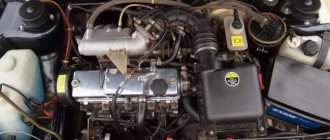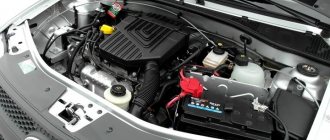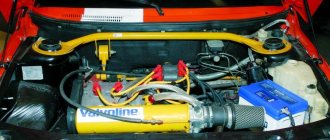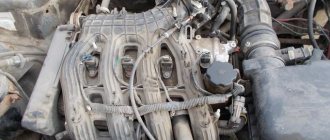The Lada of the tenth family in the hatchback body is the VAZ-2112 model. All cars of this family were produced until 2009. The range of engines included four options. Among them, by the way, were two 8-valve engines. Below we present the characteristics of 16-valve engines, but engines with 8 valves do not deserve attention. The torque graph proves these words true. So, let's look at the characteristics of VAZ-2112 engines with four valves per cylinder.
Two different 16-valve valves accelerate the car differently. Here is a video of the test drive.
History of the creation of the VAZ 21124
AvtoVAZ engineers understood that by the time of mass production of domestic 10th generation cars, the power units of the eighth and ninth generation would be very outdated. The trends of the world automotive industry demanded an increase in the power and environmental friendliness of manufactured engines. After all, European manufacturers Volkswagen, Opel, Renault produced engines much more powerful than the domestic AVTOVAZ. But in addition to power, European engines were more economical and environmentally friendly. AvtoVAZ engineers were faced with the task of creating something similar.
There were several ways to get what you wanted. In order to achieve clean exhaust gases, an unconditional decision was made to switch to distributed injection. In addition to the cleanliness of the exhaust, this solution partially solved the issues of increasing power and efficiency.
To obtain the desired power, distributed injection alone was not enough, it was decided to increase the amount of horsepower by increasing the engine size. The volume of 1.6 liters was achieved by increasing the piston stroke to 76.5 mm, which became possible after reconstructing the engine height and using a crankshaft with a large crank. The cylinder diameter has become larger, now it is 82 mm. But this modernization was not enough.
16 valve version
Further improvement in engine performance was possible by installing turbocharging or switching to a BC head, where the number of valves was doubled.
- The first option involved large capital investments and multiple technological innovations.
- The second option was less expensive. Only the cylinder head was modernized; the remaining components and systems of the engine did not require major technical changes. Doubling the number of valves improved the filling of the cylinders with the combustible mixture. This increased torque and power by almost 15 percent. As a result of all the changes, the 1.6 liter engine, which has injection power and a 16-valve head, was able to develop power up to 90 hp.
Improvements from Porsche
It should be noted here that domestic designers had no experience in designing complex structures, which was the BC head. Therefore, AvtoVAZ engineers followed the well-worn path; they turned to well-known specialists from the German concern Porsche, who in the past designed the VAZ 2108 engine for AvtoVAZ.
However, Russian specialists did not sit idle and in parallel carried out work on creating the 16 V cylinder head. As a result, the design proposed by Porsche specialists required a gasket of a very complex shape. The Elring company from Germany offered to solve the issue of creating a gasket. The asking price was almost half a million German marks, which of course did not suit AvtoVAZ representatives. As a result, the issue with the invention of the gasket was solved by specialists from RTI STC for one and a half thousand Soviet rubles.
When completing the design of the 16 V cylinder head, Porsche specialists encountered certain difficulties. We had to involve highly specialized specialists from Italy and Australia. Ultimately, the 16 V cylinder head created for the 10th generation of Volzhsky Automobile Plant engines turned out to be original and multinational, with a unique design. At the same time, the first engines on which this cylinder head was installed had insert wells. And only on the VAZ 21124 engine, in 2004, the 16 V cylinder head, modernized by Russian engineers, received cast spark plug wells, as was originally intended at AvtoVAZ.
Some conclusions
The steel receiver looks powerful and beautiful
All VAZ-2112 hatchback engines differ in characteristics, and the differences are significant. It seems that the best option would be a 16-valve 1.5-liter engine. But the 21124 (1.6) engine has its advantages:
- Rated power is achieved at 5000 rpm rather than 5600;
- A broken timing belt does not lead to bending of the valves and their replacement;
- It is acceptable to use 92nd gasoline.
Technical data VAZ 21124
VAZ 21124 is a four-stroke gasoline engine with an injection power system. The four cylinders of the internal combustion engine are arranged in one row. The location in the engine compartment is transverse. The material used to make the BC is highly durable cast iron.
- The gas distribution system has two camshafts and 16 valves, 4 per cylinder.
- The exact engine capacity is 1599 cc. cm.
- The piston has a stroke length of 75.6 millimeters and its diameter is 82 mm.
- The torque of the internal combustion engine 21124 at 3700 rpm is 131 Nm. The power of this internal combustion engine is 89 hp. Compression ratio 21124 - 10.3:1.
Graphs of 16 valve engines - power and torque
All engines of the “tenth hatchbacks” are ordered by power as follows: 21120, 21124, 21114 and 2111. They develop 93, 90, 81 and 77 “forces”. The graph shows how power varies with rpm.
The first two engines, 20 and 124, are 16-valve. Both belong to the Euro-3 class.
Engines 21124 of later years of production meet Euro-4 standards. They have an improved catalyst installed. The ECU unit was also installed differently, updated.
124 engine under the hood of the “two-wheeler”
The pistons of the 124 series engines have grooves for the valves. Simply put, the internal combustion engine of the VAZ-21120 is plug-in (valve bending as a result of a broken timing belt, the valves will need to be replaced, and then it depends), and 21124 is not plug-in (does not bend the valve). Let's estimate the torque.
The most interesting thing here is the VAZ-21120 engine. In terms of “low-end traction” it is not much inferior to 8-valve engines.
Formal characteristics
Here are the characteristics of two different motors:
- ICE model: 21120/21124;
- Working volume: 1,488/1,596 l;
- Compression ratio: 10.5/10.3;
- Power: 93/90 hp;
- Rated power speed: 5600/5000 rpm;
- Maximum torque: 140/131 N*m;
- Recommended fuel: AI-95/AI-95;
- Ecology: Euro-3/Euro-4 or Euro-3.
The lower the compression ratio, the more “omnivorous” the engine will be in relation to fuel.
Main design features of the VAZ 21124 engine
The VAZ 21124 power unit is a union of two engines: the BC head is used from the VAZ 2112, and the ShPG, cylinder block, lubrication system and other internal components are copied from the VAZ 21114.
Cylinder head
The BC head on model 21124 was slightly modified. The spark plug wells on it are cast, instead of removable, which were originally used on the VAZ 2112. The design of other components is completely identical to the initial version, it also has two shafts for distributing flammable gases and 16 valves, 2 inlet and 2 outlet for each of the four cylinders Just like on the 12th head, there are hydraulic pushers here, eliminating the need for periodic adjustment of the thermal clearances of the valves. The dilution of the intake and exhaust gas flows is of great importance.
It is this technology that significantly increases the power of the power unit, its efficiency and reduces exhaust emissions. The timing belt drive has a safe and reliable mechanism. Thanks to the design of the pistons, which have holes on the bottom, drivers do not have to worry that when the timing belt breaks, the piston hits the valves. The use of a belt to drive the gas distribution mechanism contributed to the quiet operation of the internal combustion engine. To service the gas distribution drive mechanism, it is enough to tighten the belt using a roller after a mileage of 15 thousand km.
Cylinder block
We figured out the design of the cylinder head. Now let's look at the lower part of the engine, which is based on the 21114 power unit. The main idea of the design is to increase the volume to 1.6 liters. To increase the volume of the power unit, AvtoVAZ engineers increased the diameter of the cylinders and their height. Accordingly, it was necessary to increase the piston stroke length. To do this, we had to increase the radius of the crankshaft crank. On the 124 engine there are ignition coils, separate for each cylinder. In addition, a number of modifications to the BC were introduced, which will be discussed in a separate chapter on the design of the cylinder block.
Design features of the cylinder block
The internal combustion engine cylinder block is made of especially durable cast iron. The cylinders are drilled directly into the cylinder block. Their diameter has been increased to 82 millimeters. The interaxial distance between the cylinders is 89 mm. The height of the BC from the crankshaft axis to the top point of the BC is 197.1 mm. The crankshaft support bore has a diameter of 54.52 millimeters. Cylinder block weight 31 kg.
The VAZ 21124 block has a distinctive feature. The designers of the 21124 motor provided for increased loads and possible overheating of the BC and ShPG. They decided to further cool the pistons while the power unit was running. For these purposes, special oil nozzles were pressed into the fifth, fourth, third, and second crankshaft supports. Their task is to cool the piston heads with jets of oil while the internal combustion engine is running. This technology was used for the first time in the domestic automotive industry.
Cylinder head design features
The powerful 124 engine has earned great popularity among numerous drivers, thanks to the two-shaft 16-valve BC head.
The VAZ 21083 cylinder head served as a blank for a sixteen-valve head for domestic cars. Despite the compactness of the 083 head, foreign inventors managed to place a second shaft and 8 more valves in it. In addition, there was room to place compact hydraulic pushers. The task is automatic adjustment of thermal clearances in valves. The separated design of the intake and exhaust gases was important.
German engineers changed the shape of the combustion chamber, which made it possible to use low-octane gasoline on the 124 engine. On AI 92, the VAZ 21124 engine runs smoothly without detonation.
Design features of the KSHG
The 124 model is equipped with a crankshaft marked 11183. Thanks to the increased crank radius of 37.8 mm, a larger piston stroke is obtained, up to 75.6 millimeters. A pulley with teeth is installed at the end of the crankshaft to drive the timing belt through a belt drive. The belt width is 25.4 mm, and its service life is 45 thousand kilometers.
Also, the pulley provides drive for additional units. The pulley design is made in the form of a damper that dampens vibration of internal combustion engine mechanisms and components. A gear wheel is built into the damper; it is needed to determine the position of the DPKV crankshaft.
The pistons for 124 engines have an improved design, thanks to which the valves do not bend. Piston rings made of cast iron or steel. The pistons are connected to the connecting rods using pins that have a floating connection and are secured with retaining rings. The connecting rods and fingers are taken from the VAZ 2110 model.
Features of the VAZ 21124 ignition system
The ignition control on the 124 engine is carried out by a Russian control unit of the January 7.2 or BoshM7.9.7 type. The ignition system provides individual ignition coils with additional fixation in the valve cover. With this design, high voltage wires were not needed. This system contributes to the smooth and reliable operation of the engine.
Cylinder head
There are no significant differences from the cylinder head of the 2112 engine. The only thing is a large surface area for joining the intake pipe flanges. The intake and exhaust camshafts, valves, springs and hydraulic lifters remain from the 2112 model.
The Lada of the tenth family in the hatchback body is the VAZ-2112 model. All cars of this family were produced until 2009. The range of engines included four options. Among them, by the way, were two 8-valve engines. Below we present the characteristics of 16-valve engines, but engines with 8 valves do not deserve attention. The torque graph proves these words true. So, let's look at the characteristics of VAZ-2112 engines with four valves per cylinder.
Two different 16-valve valves accelerate the car differently. Here is a video of the test drive.
Typical malfunctions of 124 motors
Engine tripping
The most common problem with this power unit is tripping. The engine is unstable, increased vibration and detonation appear. There can be many reasons for this. To find the real reason, you need to perform a number of actions in a certain sequence:
- the engine may stall due to mechanical reasons, namely due to burnout of one of the valves. To exclude this possibility, you need to measure the compression in all cylinders. If the compression in all cylinders is the same, then the reason should be sought elsewhere;
- The cause of the tripping may be the ignition system. To determine this suspicion, remove the caps from all candles one by one. If the shaking intensifies when you remove the cap, it means that the spark plug or the individual ignition coil is not working and needs to be replaced to solve the problem. If the tripping has not changed, you need to check the serviceability of the ignition module. To find out, you should replace the module with another, working electronic device. If this is not possible, then the ignition module should be ringed with the device;
- Engine trouble is often due to dirty injectors; to eliminate the problem, the injectors must be cleaned;
- It is possible that the engine will trip due to electronic glitches. You should try replacing the ECU with a known good one or diagnosing the electronic device;
- It happens that the motor stalls due to problems with some sensor. This could be a sensor indicating the position of the crankshaft, or a TPS.
On a 124 engine the idle speed often fluctuates
The reason is most often ECU glitches, or problems with the IAC or mass flow sensor. You can determine what exactly is faulty by replacing the spare part with a working one or by ringing the device.
Knocks
Engine knocking may be a sign of a stretched timing belt, or hydraulic tappets may be knocking if poor quality fuel is used.
Replacing hydraulic compensators
Tuning
Simple firmware or chip tuning for 124 engines not the technical characteristics . To significantly increase power, it is necessary to modify the engine.
- The simplest and most common tuning of the 21124 engine is the installation of sports camshafts, a direct-flow resonator, an increased throttle - in this way you can increase the power to 120 hp. Installing a lighter piston engine can add some power to this. This, at the same time, will reduce the fuel consumption of the VAZ 21124.
- About 150 hp can be ensured by modification of the cylinder head and installation of camshafts with increased valve opening phases.
- Installing a compressor has approximately the same effect; it is installed on eight-valve and sixteen-valve engines.
- Stable engine operation at any speed is ensured by installing four chokes, one for each cylinder. According to popular experience, the most suitable option is to install an injection system from ToyotaLevin. To do this, a set is assembled from the chokes themselves, an adapter manifold, a zero-resistance filter, injectors, an absolute pressure sensor and a fuel pressure regulator. Due to the fact that the speed exceeds the limit, it is necessary to install lightweight piston and wide-phase camshafts. With this modification, engine power can reach 200 hp. But such modernization sharply reduces the service life of the engine, is fraught with frequent breakdowns and the need to carry out serious repairs of the VAZ 124, due to the fact that the engine easily and often spins up to 9,000 rpm.
Problems
But despite all the positive qualities, according to the tradition of domestic engineers, there were some common breakdowns. But most of them have been studied by the owners for a long time, so you won’t have to spend a lot of effort, time and money to eliminate them:
- The VAZ 21124 engine speed may begin to fluctuate when idling. As a rule, this problem can be solved by simply cleaning the throttle valve. But if this does not help, then you should pay attention to the VAZ 21124 engine sensors. The mass air flow sensor, DPK, TPS or idle speed controller may start to malfunction.
- It also happens that the VAZ 21124 engine troits. Most often, the cause of this problem is injectors that are simply clogged from using low-quality gasoline. Less commonly, ignition coils or spark plugs can fail. Valve burnout can also cause a similar malfunction, but this is extremely rare.
- Various types of knocking noises may appear in the engine, which in most cases are produced by worn-out hydraulic compensators. Another reason may be that the timing belt has stretched.
- If the engine starts knocking and knocking, then you should pay attention to the pressure of the VAZ 21124 engine, since this is the first sign of the need for a major overhaul of the internal combustion engine. As a rule, due to mileage or bad oil, the ShPG simply wears out.
Why is verification needed?
After long-term operation, the 16-valve VAZ 2110 engine begins to operate unevenly, smoke, and fuel and oil consumption increases. The cause of such problems may be significant wear of the connecting rod and piston group. To find out, it is not necessary to completely disassemble the engine; it is enough to measure the pressure in its cylinders depending on what compression it is to draw conclusions about the serviceability of the components.
The pressure in the cylinders may decrease for the following reasons:
What is the standard compression for a VAZ 2110 with 16 valves can be calculated using the following formula:
Compression = compression ratio * K factor
The compression ratio is indicated in the vehicle's owner's manual and is different for each model. The K coefficient depends on the type of engine: for a gasoline engine it is 1.2, for a diesel engine it is 1.8. Experienced drivers do not need calculations, since they know from their experience what compression should be on their car.
You should regularly measure the compression in the cylinders in order to diagnose and eliminate problems in a timely manner without bringing the engine to overhaul. Measurements are taken with the carburetor flaps open and closed.
An open damper makes it possible to detect the following problems:
When the damper is closed, you can determine:
We do a check for a 16-valve car
To carry out a compression test on a 16-valve VAZ 2110 engine, it is better to invite an assistant and prepare the following tools:
When choosing a device, you should pay attention to its limit switch, which is used to connect to the engine. It can be threaded or rubber. It is better to choose one with threads, this will make the work easier.
Many VAZ-2110 owners wonder why their cars have different compression? Typically, compression is injected as the piston moves from the bottom to the top. In this case, a certain pressure is created in the cylinder. Good compression can only happen if all gaskets, pistons, rings or valves are in good condition. It is because of these elements that the air in the system is compressed.
Results
No matter what anyone says, the VAZ-21104 car, the photo of which is presented in this article, belongs entirely to AvtoVAZ. Namely, his idea of creation was developed without anyone's support. Thanks to him, a new era began in the Russian automobile industry. The described machine fully met the requirements of the buyer of that time. It had maximum functionality, was quite practical and economical. Of course, when compared with imported options, there is still room for improvement, but it is better to achieve it slowly, focusing on quality.
Supply system
This component is designed to prepare an air-fuel emulsion and deliver it to the cylinder inlets. It consists of 3 parts: air supply system, gasoline and receiver.
The fuel system includes a fuel rail with injectors, an electric pump, a tank and connecting pipes. The air supply system consists of a paper air filter, hoses and a throttle assembly.
The fuel supply works as follows. Based on a signal from the engine control unit, the pump is turned on and fuel enters the ramp. From it, fuel is injected through nozzles into the receiver, where it is mixed with air. The resulting mixture is drawn into it using the vacuum in the cylinder.
Reliability
The reliability of the VAZ-21124 internal combustion engine is indicated by the fact that it exceeds the mileage life established by the manufacturer. There are engines that have gone through more than 300 thousand km without major repairs. This is clearly visible from the communications of forum members. Thus, Maxim writes: “... an engine with a long service life. Mileage 330 thousand. Doesn't take oil. Replace the timing belt according to the regulations, every 45-50 thousand km, pump every 100 thousand. The oil was 5-40 synthetic.”
The manufacturer constantly makes changes to the design of the motor in order to increase its reliability. There has been a decrease in electrical failures (due to the abandonment of high-voltage wires, the installation of individual coils and other innovations).
Maintainability
All car enthusiasts note the high maintainability of the engine. Indeed, a cast-iron cylinder block allows cylinders to be bored repeatedly, which means that major overhauls of the internal combustion engine can be done several times.
There are no problems in selecting spare parts for restoration. They are available in any variety in every specialty store. The only trouble that an inexperienced car owner can run into is experiencing the possibility of purchasing counterfeit products. The Chinese manufacturer is considered especially “dangerous” in the supply of such spare parts.
The interchangeability of parts, assemblies and mechanisms from other engines in the VAZ 16V line is of great help to the car owner when repairing the unit.
The repair itself is simple and accessible to anyone who has little experience in performing such work. Many car enthusiasts take advantage of this and restore engines in garage conditions.
By the way, car services are also happy to take on this work due to its simplicity.
In the most extreme case, the engine can be replaced with a contract one, but difficulties may arise with its acquisition, or rather, with its search. The fact is that the VAZ-21124 internal combustion engine is included in the category of scarce ones on the secondary market.
Conclusion: unit repair is available not only to professionals, but also to amateurs.
Repair
As I wrote above, it’s really difficult to make repairs yourself. Unless, of course, you have a blown gasket, it’s possible to repair it, but again, it’s not so easy. How to replace a short video.
Diagnostics are carried out with the cylinder head removed - here the malfunction can be determined 100%. You are unlikely to do it yourself; contact specialists at a service station, or people who understand.
You can diagnose the parts of the power unit without disassembling it. For correct diagnosis, you need to know what compression should be in 2110. The article contains information on methods for measuring compression and detailed instructions with a video test of a 16-valve engine.











